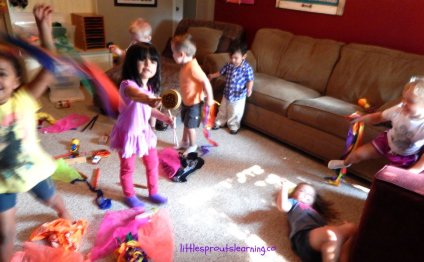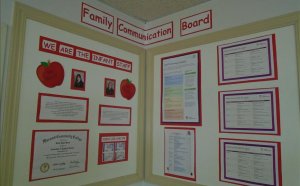
Music and movement lesson plans for Preschoolers
MUSIC AND MOVEMENT ACTIVITIES
Music and dancing are inside each child. All caregivers do is let them out. That is good news for those of us who are not gifted in these areas. It tells us that all we need to do is encourage, not "teach" music and movement. Here are some ideas that may help you "let the music out."
MUSIC ACTIVITIES
Make music.
Sing as you work. Any and all songs are acceptable. Sing songs you know or make up new ones. The easiest way to make up a new song is to sing new words to familiar tunes. For example, to the tune of "Here We Go Round the Mulberry Bush, " you may sing:
This is the way we set the table, set the table, set the table; This is the way we set the table, so we can all eat lunch.
Or you might sing the following to the tune of "Farmer in the Dell":
Mary picks up toys, Mary picks up toys;
Heigh ho the derry oh, Mary picks up toys.
Mary gets some help...
John piles the blocks...
Add children's names or use different actions as you go along.
You can also sing along with records or tapes. Children's artists (Raffi, Pete Seeger, Hap Palmer, Mr. Rogers, and your own favorites) have recorded many songs that are especially appealing to children. Many libraries have children's tapes and records. You may also want to buy one or two. Or ask children to bring favorites from home.
Children often know popular songs on the radio. Encourage them to sing along when they come on. Singing songs together also can be fun. If you play an instrument, encourage children to sing along as you play.
Respond to music.
Play music that creates a mood (for example, a lullaby, a march, slow and dreamy music, or Latin rhythms) or music that features one instrument (such as the violin, trumpet, organ, or drums). Let children respond by painting, finger painting, using markers or crayons, or shaping play dough. Encourage participation by making comments such as, "Why don't you paint how the music makes you feel?" or "That fast music helped you make so many little lines." Commenting on the child's activity ("You are moving slowly now") rather than praising the art ("That's a pretty picture") is more likely to encourage creativity in their responses.
MOVEMENT ACTIVITIES
Movement describes what young children do. They are rarely still. As you plan movement activities for your children, consider activity records such as those by Hap Palmer. Or try exercising. It's fun and helps everyone stay flexible and feel fit! Think of ways to let children create their own dance movements - to let the dancing out of the child.
Hear and feel rhythms by clapping.
Try clapping together as a group. Start with one steady beat:
CLAP, CLAP, CLAP.
Then try two with the first beat accented: CLAP-CLAP, CLAP-CLAP.
And three: CLAP-CLAP-CLAP, CLAP-CLAP, CLAP.
And four: CLAP-CLAP-CLAP-CLAP, CLAP-CLAP-CLAP-CLAP.
After the children understand how to clap along, encourage them to move their hands or dance around the room in response to the rhythm. You can clap slow or fast. The beat may be even or uneven.
Creat a rythym band.
Try using body noises to create rhythms. Try claps (hand to hand, hand to thigh, hand to head, hand to floor, or hand to table), stamping feet, clicking tongues, or snapping fingers. Make rhythm instruments for the children to use. Tap spoons on a wooden block or knock wooden blocks together. Let children bang two pot lids together like cymbals. For four-year-olds and over, staple or tape paper plates together with dried beans in the middle, or use egg-shaped, plastic pantyhose containers taped or glued together with pebbles or dried beans inside them. Be sure the containers are securely fastened, and supervise their use. If the beans escape, they may be discovered by younger children who may put them in their mouths, ears, or noses.
Encourage moving to music.
Play a wide variety of music. Try marches, waltzes, Latin dances, current hits, and classical tunes. The greater the variety, the better. Have scarves or dress-ups that will encourage movement. You may want to join in to get the activity started. But be careful about demonstrating too much. The goal is for children to create their own movements.
Take advantage of young children's love for music and movement. The activities will help them work off excess energy, develop a love of music, and become more creative!
Reprinted with permission from the National Network for Child Care - NNCC. Morse, N.. (1995). Music and movement activities. In Todd, C.M. (Ed.), *Child care connections*, 2(1), Urbana-Champaign, IL: University of Illinois Cooperative Extension Service.
YOU MIGHT ALSO LIKE



Share this Post
Related posts
Music lesson plans for Kids
Music not only has the power to stimulate the mind, enrich the heart and soothe the soul; it also helps you meet educational…
Read MoreMusic lesson plans for Preschool
The First Steps in Music curriculum is designed to prepare children to become musical in three ways: Tuneful – to have tunes…
Read More










